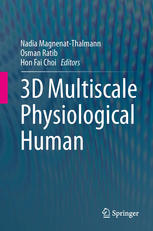3D Multiscale Physiological Human 2014
دانلود کتاب پزشکی چند مقیاسی فیزیولوژیکی سه بعدی انسان
| نویسنده |
Hon Fai Choi, Nadia Magnenat-Thalmann, Osman Ratib |
|---|
| تعداد صفحهها |
316 |
|---|---|
| نوع فایل |
|
| حجم |
10 Mb |
| سال انتشار |
2014 |
89,000 تومان
سه بعدی فیزیولوژیکی انسان چندمقیاس با گردآوری مرورهای کلی با نمونه هایی از پیشرفت های علمی و فناوری اخیر در طیف گسترده ای از رشته های تحقیقاتی، تبادل علمی را تقویت می کند. در نتیجه، تنوع روششناسی و پارادایمهای دانش متناقض است و شکافها و فرصتهای بالقوه را برای یکپارچگی آشکار میکند. نویسندگان منتخب به فصلهایی در زمینههای مرتبط مهندسی بافت، اکتساب و پردازش تصویر پزشکی، تجسم، مدلسازی، تشخیص به کمک رایانه و مدیریت دانش کمک کردهاند. جنبه های تحقیقاتی چندمقیاس و بین رشته ای بیان در انسان با تمرکز ویژه بر تشخیص پزشکی و درمان بیماری های سیستم اسکلتی عضلانی و اختلالات مرتبط برجسته شده است.
نیاز به روشهای تحقیقاتی چندمقیاسی و چند رشتهای یک الگوی نوظهور در جستجوی درک بیولوژیکی و پزشکی بهتر از سیستم اسکلتی عضلانی انسان است. این امر به ویژه به دلیل افزایش بار اجتماعی و اقتصادی ناتوانی و بیماری های سیستم اسکلتی عضلانی، به ویژه در جمعیت رو به رشد سالمندان است. حرکت انسان توسط شبکه پیچیدهای از تعاملات بین سیستمهای فیزیولوژیکی که در مقیاسهای فضایی-زمانی مختلف، از سطح مولکولی تا سطح اندام تعبیه شدهاند، ایجاد میشود. تحقیقات زیادی به درک هر یک از این سیستم ها، با استفاده از رویکردها و روش های طراحی شده برای هر مقیاس اختصاص یافته است. با این حال، گرد هم آوردن دانش از دیدگاه های مختلف، افق های جدیدی را برای تفکر علمی باز می کند و نوآوری را تحریک می کند. ادغام این موزاییک از دادههای چند وجهی در معیارها و روشهای چندگانه نیازمند کاوش بیشتر در روشها در شبیهسازی و تجسم برای یک سنتز جامع است. با این حال، این رویکرد یکپارچه نمی تواند بدون قدردانی گسترده از رشته های تحقیقاتی متعدد درگیر به دست آید.
3D Multiscale Physiological Human aims to promote scientific exchange by bringing together overviews and examples of recent scientific and technological advancements across a wide range of research disciplines. As a result, the variety in methodologies and knowledge paradigms are contrasted, revealing potential gaps and opportunities for integration. Chapters have been contributed by selected authors in the relevant domains of tissue engineering, medical image acquisition and processing, visualization, modeling, computer aided diagnosis and knowledge management. The multi-scale and multi-disciplinary research aspects of articulations in humans are highlighted, with a particular emphasis on medical diagnosis and treatment of musculoskeletal diseases and related disorders.
The need for multi-scale modalities and multi-disciplinary research is an emerging paradigm in the search for a better biological and medical understanding of the human musculoskeletal system. This is particularly motivated by the increasing socio-economic burden of disability and musculoskeletal diseases, especially in the increasing population of elderly people. Human movement is generated through a complex web of interactions between embedded physiological systems on different spatiotemporal scales, ranging from the molecular to the organ level. Much research is dedicated to the understanding of each of these systems, using methods and modalities tailored for each scale. Nevertheless, combining knowledge from different perspectives opens new venues of scientific thinking and stimulates innovation. Integration of this mosaic of multifaceted data across multiple scales and modalities requires further exploration of methods in simulations and visualization to obtain a comprehensive synthesis. However, this integrative approach cannot be achieved without a broad appreciation for the multiple research disciplines involved.




